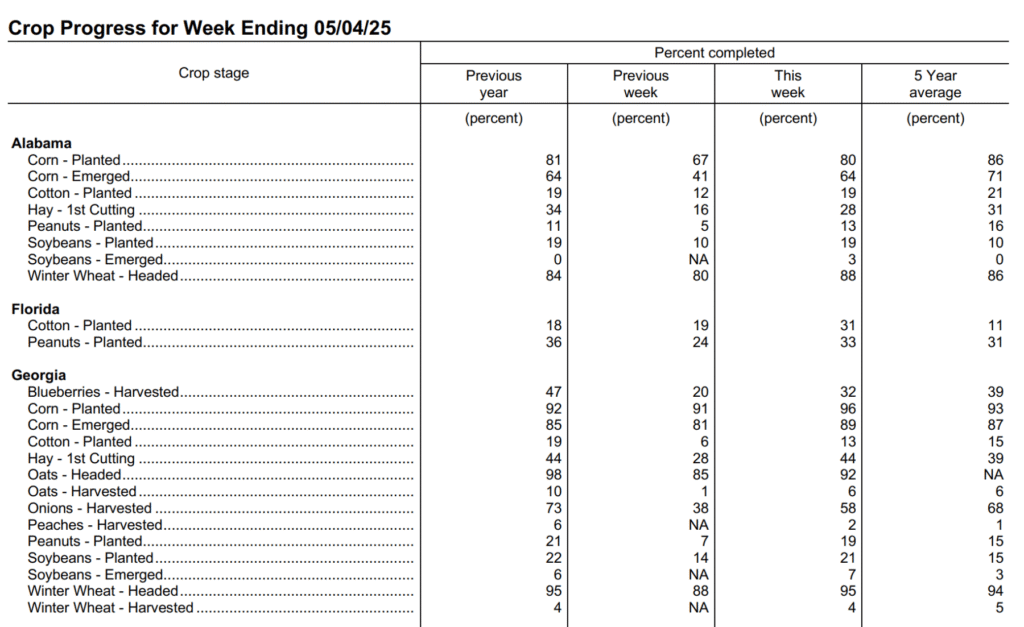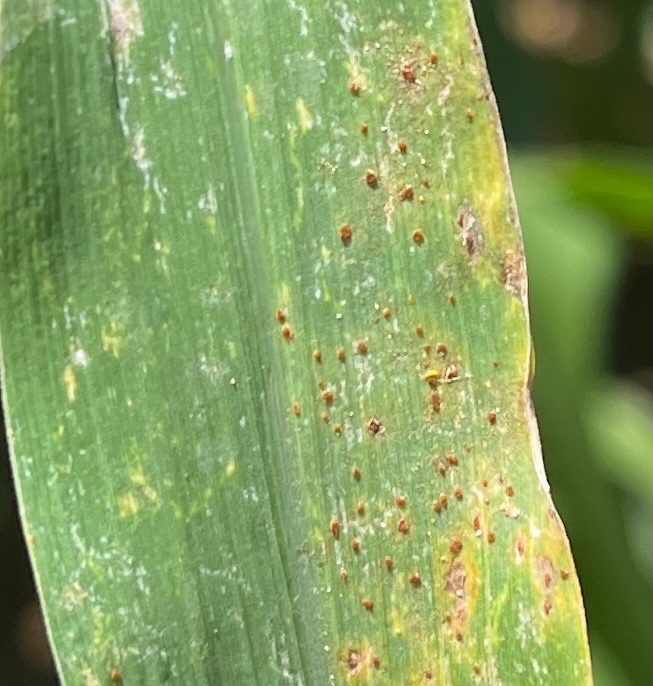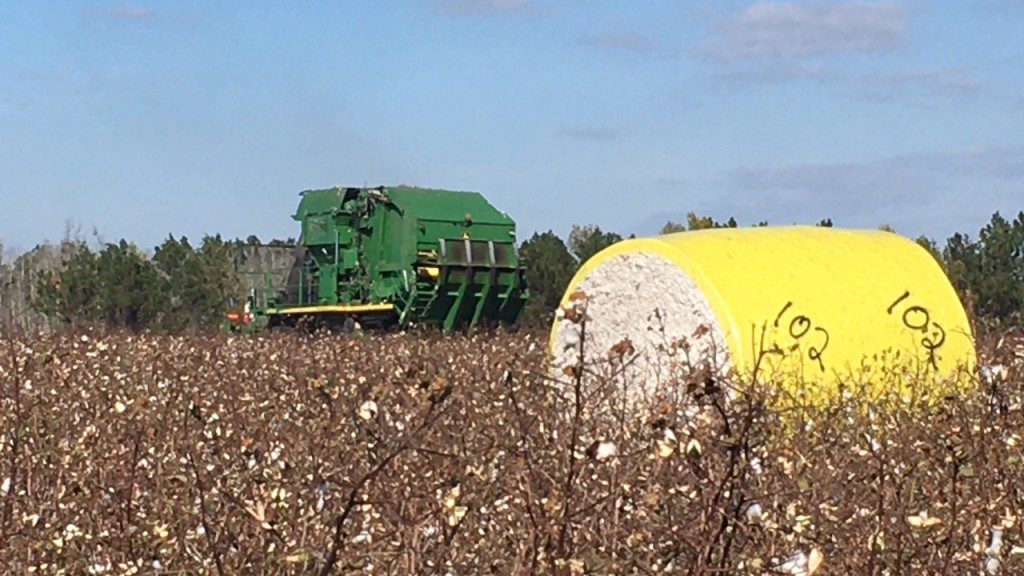The weather forecast for the next few days shows increasing chances for rain. The crop progress report shows that 13% of the cotton crop has been planted in Georgia, which is up from last week’s 6%. The Georgia peanut crop is 19% planted, up from last week’s 7%. The crop progress report is available here. The drought monitor this week shows that all of Colquitt County is experiencing either abnormally dry or moderate drought conditions.

Peanuts:
Dr. Prostko mentioned today to county agents about Valor injury and up coming weather forecast. Valor (flumioxazin) was first registered for use in peanut in 2001. Since that time, we have observed injury symptoms EVERY year across the state. Thus, it should no longer be a shock or surprise to anyone when it happens. The current predicted rainfall events over the next few days will likely result in Valor injury in some peanut fields, particularly in fields where peanuts are cracking. History and lots of data suggest that most peanut fields suffering from Valor damage will recover without yield losses.
How many pounds of peanut seed do I need? To reduce the impact ofTSWV, growers need to plant enough seed to provide at least 4 plants/ft of row. Therefore, seeding rates of 6 seed/ft on singles and 6 to 7 combined seed/ft on twins (3 to 3.5 seed/ft per twin furrow) are recommended. Seeding rates also need to be adjusted for % germ of the seed being planted to ensure you have the desired plant population. Below is a table from the 2024 UGA Peanut Agronomic guide that shows peanut seed size per variety and lbs of seed per acre based off a seeding rate of 5, 6, and 7 seed per foot.

I have received a call or two about evaluating peanut stands. According to Drs. Scott Monfort and Scott Tubbs, UGA Peanut Agronomists, we are looking for a final plant stand of at least 4 plants per foot of row to maximize yield and to minimize TSWV infection. This does not mean a grower with 2.5 to 3.5 plants per foot of row needs to replant. When evaluating a field for possible plant stand issues, if it is determined that there are at least 2.5 plants per foot of row, with a uniform distribution across the field, then it would not be recommended to replant. A grower might want to add more seed to the existing plants when plant stands are less than 2.5 plants per foot of row or there are numerous gaps more than 3 ft in length throughout the field. A field with large gaps will likely need replanting by adding more seed next to existing plants. If you have any questions, please call the Colquitt County Extension office. As we start this peanut planting season, growers please remember to take peanut seed samples when you change lots and/or fields and place them in a cool place.
Pegging Zone Sampling in Runner Peanut Peanuts have a high calcium requirement. Calcium must be available to the developing peg and pod in a water soluble form in the pegging zone area. If you need to apply calcium (in the form of gypsum, landplaster) it needs to be applied at early flowering. Pull the sample slightly offset of the peanut row about 3 inches deep. Pegging zone samples need to show 500 pounds of soil test calcium. If you are at the 500 mark or better and you have a 3 to 1 calcium to potassium ratio then calcium requirements should be met. If you do not meet EITHER of these requirements then you need to apply 1000 lb/a gypsum at early bloom. Also, all peanuts grown for seed should automatically receive this gypsum application, regardless of soil test calcium levels. Soil sample bags are available at the Extension Office if you would like to do pegging zone tests.
Cotton:
Grasshoppers: I have been getting a report or two of elevated grasshopper populations in strip till fields.. According to Dr. Phillip Roberts, UGA Cotton Entomologist, control of grasshoppers is recommended when plant damage is occurring, grasshoppers are present, and plant stands are threatened. Nymph (wingless) grasshoppers are relatively easy to control with insecticides. However, control of adult (winged) grasshoppers is more difficult. High rates of labeled pyrethroids have performed fair to good on adults (control of adults or “flyers” is difficult). Dimilin, which is an insect growth regulator, provides good control of nymphal grasshoppers and has provided good residual activity in field demos, but it takes a few days to cause mortality. Dimilin will not control adult grasshoppers. According to Dr Phillip Roberts, acephate applied at higher rates would be an option for control (0.75 lb).
Minimizing herbicide injury from preemergence herbicides
Planting season has started in Colquitt County and I receive numerous calls from growers, consultants and retailers about ways to minimize herbicide injury. Pre emerge herbicides form the foundation for Palmer amaranth control programs in cotton. Lets discuss some points to consider in order to minimize injury.
- Plant high vigor seed into moist soil (preplant irrigation often needed if available).
- Shallow planting depth increases herbicide injury potential.
- Apply proper PRE residual herbicides within 24 hr of planting.
- If feasible, irrigate between 30 hr after planting and prior to 24 hr before emergence. Then do not irrigate again until at least 5 days after emergence. Most often, the greatest damage occurs when the first irrigation/rainfall event happens during emergence.
- Irrigate to develop a perfect cotton stand; however, limit irrigation events during the first two weeks after planting to as few as possible after activating residual herbicides.
Corn: The corn crop ranges from V2 to pre tassel. Growers are applying nitrogen and herbicides to their corn crop. I had a few questions about foliar burn from urea applications. Dr. Erik Larson, MSU Small Grains Agronomist, suggests that in order to minimize leaf burn from top-dress application, we generally suggest applying no more than 150 lbs/a of urea per application on corn taller than three feet. For broadcast AN or urea, apply when corn leaves are DRY during mid to late morning and afternoon. Dr. Larson had a blog post about this a while back.
I have received a question or two about stinkbugs in corn. The UGA Corn production guide mentions that stinkbugs feed by piercing and sucking sap from corn seedlings. Common species in Georgia are the Southern green, green, and brown stink bugs. Feeding in the seedling stage stunts and deforms developing whorls. New leaves do not expand properly and are trapped in the previous leaf causing “buggy-whip” type damage. Stink bugs are very difficult to scout in the seedling stage. About 10% seedling damage is economically important. Most at-planting insecticides are not effective in preventing stink bug damage. Systemic seed treatments, Poncho and Cruiser at the 500 or 1250 rates are needed for control. Dr. Roberts says the picture below is possible stinkbug injury.

How to identify corn stages of development.
How a Corn Plant Develops – An excellent publication by Iowa State University on the development of corn.
How to Determine Corn Vegetative Growth Stages | Mississippi Crop Situation
Video – How to Identify Corn Vegetative Growth Stages | Mississippi Crop Situation
I found some common rust this week in field and sweet corn. According to Dr. Bob , common corn rust (Puccinia sorghii) is NOT a threat to our corn. It can be differentiated from the potentially devastating southern corn rust (Puccinia polysora) because a) common rust pustules are dark cinnamon color (as opposed to yellow-orange), b) common rust pustules occur on the upper AND lower sides of the leaf, and c) spores of P. sorghii are fish-eye shaped while P. polysora spores are more oval and lack a thickened wall. Common rust usually occurs much earlier in the season than does southern rust.

How do I take a tissue sample in corn?
Plant tissue sampling should be used in tandem with soil sampling to determine:
(1) If essential elements are presently low, adequate or excessive in the plant and;
(2) Whether the proper ratio of certain elements exists.
It is advisable to take plant tissue samples throughout the growing season to monitor nutrient status and detect any deficiencies or imbalances. If a deficiency or imbalance is detected early enough, it can usually be corrected in time to improve yield.
In corn there are 3 good opportunities to do tissue analysis.
1. Seedling stage (all of the above ground corn) 15-20 plants
2. Prior to tasseling (the first fully developed leaf just below the whorl) 15-20 leaves
3. From tasselling and shooting to silking (the entire leaf at the ear node or immediately above or below) 15-20 leaves
If you have any questions please contact your local county Extension agent.
Have a great week,
Jeremy M. Kichler
Colquitt County Extension Coordinator
The University of Georgia Cooperative Extension does not endorse or guarantee the performance any products mentioned in this update.
